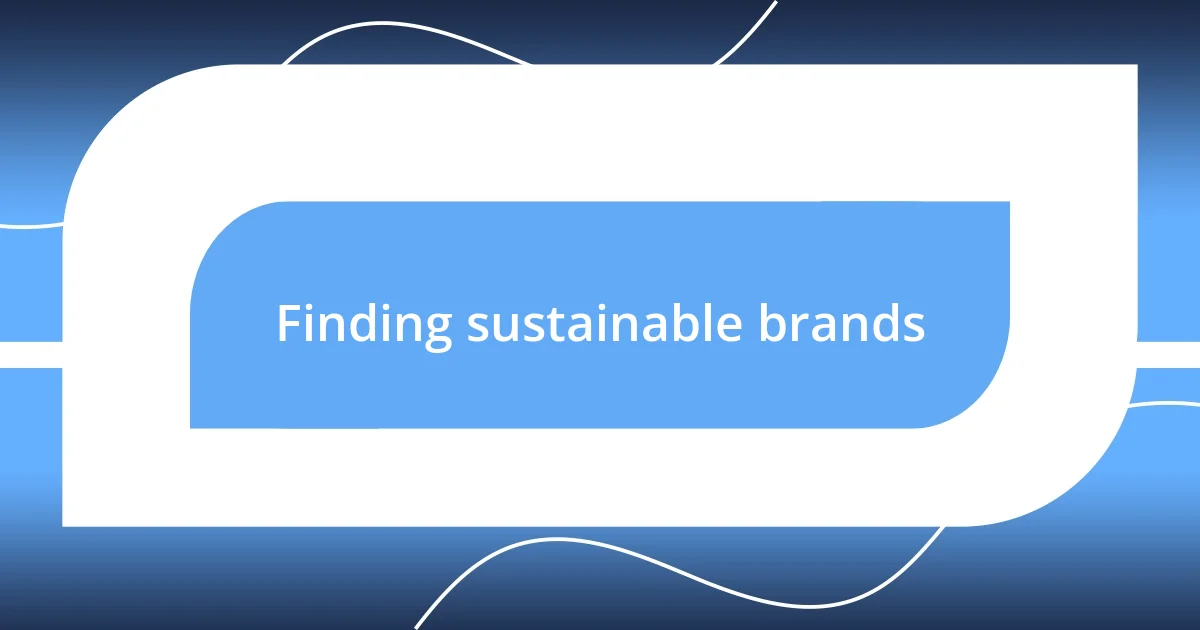Key takeaways:
- The author’s realization of the negative impacts of fast fashion prompted a shift towards ethical shopping, prioritizing sustainability and fair labor practices.
- Defining ethical fashion involves understanding principles like fair labor, transparency in production, and promoting a circular economy.
- Sharing knowledge and experiences about ethical fashion has inspired others to reconsider their shopping habits and embrace sustainable practices.

My journey to ethical fashion
As I sifted through my closet one day, a wave of guilt washed over me. Each piece of clothing felt like a reminder of the countless hours of labor and environmental degradation that went into making them. Have you ever looked at a shirt and wondered about its journey before it reached you? That was my turning point; I realized I wanted my wardrobe choices to reflect my values.
I vividly recall the moment I stumbled upon a documentary about fast fashion. It was eye-opening to see the impact my consumption had on both people and the planet. I remember thinking, “How could I have been so unaware?” That moment ignited a fire in me to research ethical brands and support companies that prioritize sustainability and fair labor practices.
In the following months, my shopping habits transformed drastically. I began thrifting and swapping clothes with friends, realizing that fashion could be fun and responsible. Each new find felt like a small victory, a way to step away from consumerism without sacrificing my style. It felt liberating, and I often catch myself wondering, “Why didn’t I do this sooner?”

Defining ethical fashion practices
Defining ethical fashion practices starts with understanding the principles that guide them. At its core, ethical fashion emphasizes fair treatment of workers, sustainable production methods, and a commitment to the environment. I recall a particularly eye-opening moment when I learned that some brands pay their factory workers less than a living wage. It was shocking to think that something I wore could come at such a high cost to someone else.
Another element to consider is transparency in the supply chain. Ethically produced garments have clear origins and production processes. I vividly remember discovering a local brand that provided detailed insights into where their fabrics were sourced and how their workers were treated. This kind of knowledge not only helps consumers make informed choices but allows them to feel connected to the story behind their clothes.
Finally, ethical fashion often promotes a circular economy. This means prioritizing items that can be reused, recycled, or repaired rather than discarded. I often find joy in mending my clothing or giving them a new life through creative alterations. It’s a fulfilling experience that emphasizes sustainability while keeping my wardrobe fresh and unique.
| Principle | Description |
|---|---|
| Fair Labor Practices | Ensuring fair wages and safe working conditions for all workers involved in the fashion supply chain. |
| Transparency | Providing clear information on sourcing and production processes, allowing consumers to make informed choices. |
| Circular Economy | Promoting reuse, recycling, or repair of clothing to minimize waste and encourage sustainability. |

Finding sustainable brands
Finding sustainable brands has become an exciting adventure for me. I remember scrolling through social media and discovering various influencers who champion ethical fashion. Their enthusiasm was contagious, and I found myself diving deeper into the world of sustainable brands. It felt exhilarating to uncover companies that align with my values, making every purchase feel meaningful. I think it’s important to trust your instincts; if a brand resonates with your sense of ethics, it’s worth exploring further.
Here are some ways I’ve successfully found sustainable brands:
- Research Online: Websites like Good On You provide ratings for brands based on their environmental impact and labor practices.
- Follow Social Media: Many sustainable fashion advocates share their favorite brands and products on platforms like Instagram.
- Explore Local Markets: Visiting local artisanal markets helped me connect with designers who prioritize sustainability.
- Read Reviews: Customer feedback on sustainability practices can give insight into a brand’s commitment to ethical practices.
In this journey, I’ve often encountered unexpected gems that truly reflect how much I care about my choices. Finding a brand that not only looks good but feels good has turned shopping into a joyful exploration rather than a mindless task.

The impact of fast fashion
The impact of fast fashion extends far beyond low prices and trendy styles. I vividly remember shopping at a popular retail chain, enamored by the diverse clothing choices. It wasn’t until I learned about the environmental repercussions—like immense water waste and pollution—that I felt a pang of guilt for every impulsive purchase. How could I have overlooked the hidden cost behind those seemingly innocent clothes?
Additionally, the culture of fast fashion fosters excessive consumption and disposability. I often found myself caught in a cycle of buying cheap garments that quickly lost their appeal. Looking back, it pains me to think about the hundreds of items I discarded without a second thought. This experience led me to question: what message does this send about our values as consumers? The incessant desire for the next “must-have” piece only fuels a system that exploits both the planet and its people.
Ultimately, fast fashion places immense pressure on workers—many of whom endure deplorable working conditions for minimal pay. I’ve come across stories of people toiling in sweatshops, making garments that sell in stores for mere dollars. This stark contrast left me feeling inconsolable. By choosing fast fashion, I was unknowingly contributing to a cycle of exploitation and inequality. It became crystal clear to me that a shift was necessary—not only in my shopping habits but also in the way we view fashion as a whole.

Making informed purchasing decisions
Making informed purchasing decisions in fashion has required me to develop a critical eye. I vividly recall the moment I stood in front of my wardrobe, realizing how many pieces I had bought on whims. I began asking myself: Do I really need this? Is it truly sustainable? These questions transformed my approach to shopping, urging me to consider not just the price tag but the bigger picture of each purchase.
I often find it helpful to take a moment before buying, weighing the benefits against the environmental impact. For instance, when I stumbled across a beautiful handmade dress, I dug deeper into the brand’s story. Discovering that they used eco-friendly materials and paid fair wages to their artisans brought me immense satisfaction; I was not just buying a dress, but supporting a movement towards sustainable practices. It made me think: wouldn’t every purchase feel more meaningful if we made choices based on ethics and empathy?
Embracing transparency in fashion has been enlightening. I remember visiting a local boutique that sourced its fabrics from ethical suppliers. The owner shared story after story about the artisans behind the pieces. This experience showed me that informed purchases aren’t solely about sustainability; they’re also about connecting with the stories and people behind our clothes. I realized that when I choose wisely, I’m not just obtaining an item; I’m becoming a part of a narrative that values the earth and its inhabitants.

Building a conscious wardrobe
Building a conscious wardrobe has truly transformed my relationship with clothing. I remember the first time I decided to purge my closet of pieces that no longer served me. It felt liberating to let go of items I’d held onto purely out of habit, making room for a few high-quality, versatile pieces instead. This shift not only minimized clutter but also allowed me to appreciate what I wore daily.
As I embraced this journey, I found joy in seeking out brands that align with my values. One day, while browsing a thrift store, I stumbled upon a vintage jacket that caught my eye immediately. Each time I wear it, I feel a profound connection to its past and the stories it carries. This experience highlighted for me that conscious fashion is not just about new purchases; it’s also about cherishing the history behind pre-loved items. I can’t help but wonder: what hidden narratives do the clothes in your closet hold?
I’ve also started to prioritize versatility when choosing new additions to my wardrobe. Nowadays, I often ask myself: can this piece be styled multiple ways? Recently, I bought a sustainable sweater that I can dress up for work or wear casually on weekends. Knowing that one item can serve various purposes helps reduce unnecessary purchases. I love how conscious choices lead to both financial savings and a more curated wardrobe, emphasizing quality over quantity. Isn’t it empowering to create a collection that reflects who we truly are while honoring our planet?

Sharing knowledge and inspiring others
I find that sharing my journey into ethical fashion has become a powerful way to inspire others. I remember discussing my experiences with a friend who was frustrated with fast fashion’s negative impact. As I told her about the brands I discovered and the conscious choices I made, I could see her curiosity spark. It’s fascinating how one conversation can plant the seed for someone to reconsider their shopping habits and become more aware of their impact. Have you ever experienced a shift in perspective simply because someone shared their story?
Every time I post about ethical fashion on social media, I am overwhelmed by the response. It seems that people are eager for discussions around sustainability, but they often don’t know where to start. I once shared a photo of my thrifted outfit and included tips on how to find the best pieces. The messages flooded in with questions, and by simply sharing what I had learned, I felt like I opened a door for others to explore this new way of thinking. It’s remarkable to witness others embark on their journeys, knowing that a little knowledge can stir real change.
I also love hosting small gatherings where friends can bring clothes they no longer want and trade them. The excitement buzzing in the room as we sift through each other’s items is contagious. Not only are we giving our clothes a second life, but we’re also fostering conversations about our clothing choices and the ethics behind them. When friends ask about the movements behind certain brands or why I support sustainable practices, I realize that sharing knowledge is just as fulfilling as implementing it in my life. Don’t you think it feels satisfying to see someone else take those first steps toward conscious fashion because of your influence?














